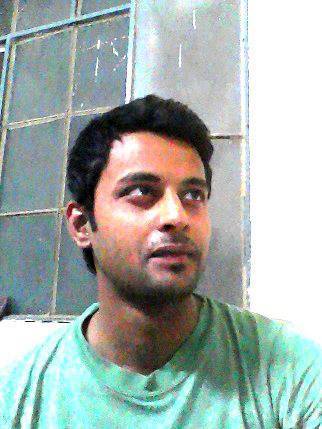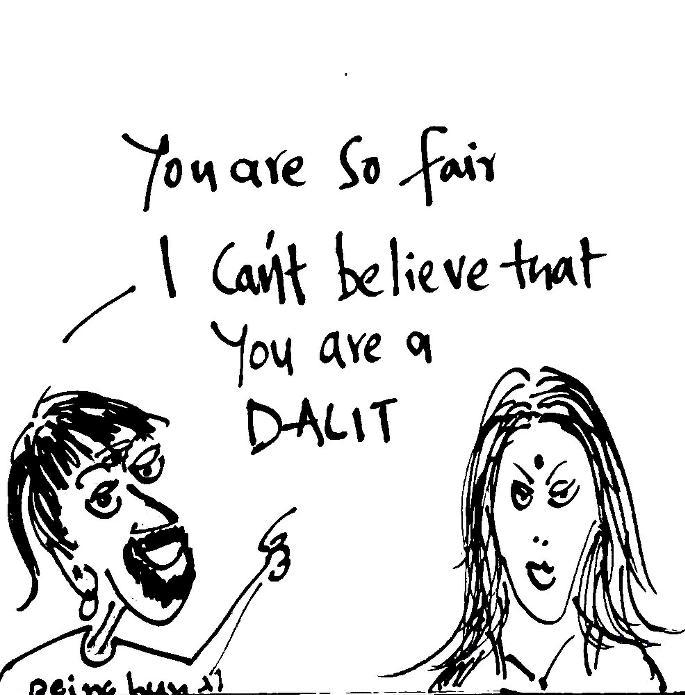Nidhin Shobhana
 In today’s editorial page of Indian Express, Ramachandra Guha has written an essay by the title ‘Does Gandhi have a Caste?‘[1] In the essay, Guha tries really hard to establish how Gandhi swept against caste, weaved against caste, sanitized toilets against caste, so on and so forth. He also quotes extensively from a White Jewish friend of Gandhi to argue how he was a Vaisya, Brahmin, Kshatriya and Shudra in his actions, all at the same time. What is interesting is how the White Jew and Guha seem happy with the basic Varna scheme and its fixed definitions for Brahmins (Teacher), Kshatriya (Protector), Vaisya (Entrepreneur) and Shudra (Servant).
In today’s editorial page of Indian Express, Ramachandra Guha has written an essay by the title ‘Does Gandhi have a Caste?‘[1] In the essay, Guha tries really hard to establish how Gandhi swept against caste, weaved against caste, sanitized toilets against caste, so on and so forth. He also quotes extensively from a White Jewish friend of Gandhi to argue how he was a Vaisya, Brahmin, Kshatriya and Shudra in his actions, all at the same time. What is interesting is how the White Jew and Guha seem happy with the basic Varna scheme and its fixed definitions for Brahmins (Teacher), Kshatriya (Protector), Vaisya (Entrepreneur) and Shudra (Servant).
If we were to apply Kancha Illiah’s definitions to the Varna Scheme, a Brahmin would be a ‘Spiritual Fascist’, Vaisya would be a ‘Social Smuggler’ and Shudras/ Ati-Shudras/ Adivasis would be ‘unpaid teachers, scientists, economists, social doctors, engineers and food producers’. So can we say that Gandhi was a spiritual fascist and a social smuggler and a food producer at the same time? A difficult proposition indeed.
Dr. B.R.Ambedkar in his reply to Gandhi in the aftermath of Annihilation of Caste (AoC) points out that the Varna Scheme, in whatever form, will degenerate into or produce castes leading to practices of caste-supremacy and untouchability.
However, why would Guha quote Ambedkar? It would simply override his purpose. What is his stated purpose?
He wants to argue that Gandhi was over and above castes or he belonged to all castes. And why would he make such an argument?
May be, in the years to come, Guha wants some other Brahmin or twice-born man to write an article with a presumptuous title ‘Does Guha have a Caste?’
The identity politics of the Brahmin-Savarna Male is the lifeblood of Hinduism and the Nation. Constantly we are in a systemic cycle of celebrating the actions and minds of Dvija men. The sights of these men cleaning toilets or farming are subjects of collective social reverence. Why? The answer to this question is enmeshed in values of caste and patriarchy. In any caste household, the sight of the eldest man cooking or cleaning would invoke deep admirations or sympathies. On the other hand, if the same actions are performed even by the youngest girl in the household it invokes almost no emotions. The former is viewed as something which is done ‘out of the way’ while the latter is a matter of duty (which needs to performed in strict adherence to rules of purity and pollution). If we were to now scale up the caste household to a brahmin-supremacist caste society, the sight of a twice born man acting like ‘lower-castes or women’ would inspire deep admiration or sympathies. During the Anti-Mandal agitations, young ‘twice-born’ men were sweeping the streets and selling vegetables as symbolic acts of protest. These demonstrations inspired righteous anger and admiration among delhicentric agitators and scholars. Prof. Yogendra Singh, in one of his press statements, qualifies them as youth making ‘national’ sacrifices.

In his essay, Guha recollects how Gandhi identified himself as a farmer and weaver in one of his court appearances in 1922. It apparently perplexed the judge. Consequently, Guha argues that Gandhi’s Mod Bania Caste was ‘irrelevant to his personal and public life’. In this argument, Guha assumes that caste and occupation are always, intrinsically linked to each other. Incidentally, in the year 1922, Lakshmi Narasu writes a very important book titled ‘A Study of Caste’. He argues, that one finds Brahmins and other upper-castes as potato cultivators, merchants, cooks, teachers, policemen etc. In fact, in many provinces large sections of the Brahmin populations identified themselves as ‘Brahmins’ and ‘farmers’ in the Census Reports of early 20th century. Can we then conclude that these Brahmins were simply making their caste origins irrelevant by ‘farming’? Lakshmi Narasu argues that castes cannot be seen as a division based of occupations. On the other hand, it should be viewed as a system which closes down/restricts and prohibits ‘choices’ of occupations in a descending order. Being a Brahmin in the caste system meant the ability to do anything with very few or no restrictions. On the other hand, lower-castes continued with certain occupations because it was institutionally forced upon them in a caste mode of production. Thus, Gandhi weaving for fun or doing organic farming to feed his ashram were not actions beyond his caste. Most Brahmins and Savarnas living in high-end gated communities today (like Gandhi’s Ashram) have kitchen gardens and electronic sewing machines. I hope even Ramachandra Guha may also have a few gardens of his own.
One can ask a few simple questions to the Gandhi-Guha nexus – Did Gandhi’s action of cleaning toilets bring any substantive change in technologies of toilet and toilet waste disposal? Did it change the caste profile of the ‘human-power’ actually involved in mass- cleaning of toilets? The answers would be in the negative.
The worst tragedy is that Guha is given prime slot in the editorial page to argue that Dvija men’s toilets and organic farms would break castes. His essay stands embracing those of Avijit Pathak, Anand Patwardhan or Apoorv Anand. What is common among all these men? They all belong to the narrow spectrum of upper-caste ruling classes. One needs to sociologically retrieve their works as ‘texts on upper-caste male identity politics’. How are they different from other forms of so called ‘identity politics’? Well, they are different because they are powerful; they are listened to and even admired. They control means of communication (alternative or mainstream) to protect the basic instincts of upper-caste men from any form of erosion.
They are actually invested in a very difficult job. They make their ‘sacrifices’ by good-mouthing Ambedkar and anti-caste movements, in attempts to reconcile and protect their ‘caste-rights’. Guha is fighting against the growing irrelevance of his own academic projects, which are love-letters to Gandhi and Nehru, with fragmented mentions of their ‘naughty’, child-like ignorance about caste oppressions. But, why should the vast majority of the lower-castes pay any attention to such attempts? Why should they be happy to know that upper-caste Hindu men like Gandhi or Guha can clean toilets, plant a few vegetables or travel abroad or befriend Christians and adopt Dalits?
Often in such attempts of the Savarna academy and media, which is an institutional expression of Savarna identity politics, certain Gurus from subaltern communities seem to participate with a lot of vigour. However, they are largely irrelevant to the project. They just add layers of legitimacy.
~
[1]. Link to article by Ram Guha: http://indianexpress.com/article/opinion/columns/does-gandhi-have-a-caste-4700974/
~~~
Nidhin Shobhana is an artist and writer.
Cartoon by Nidhin Shobhana.










